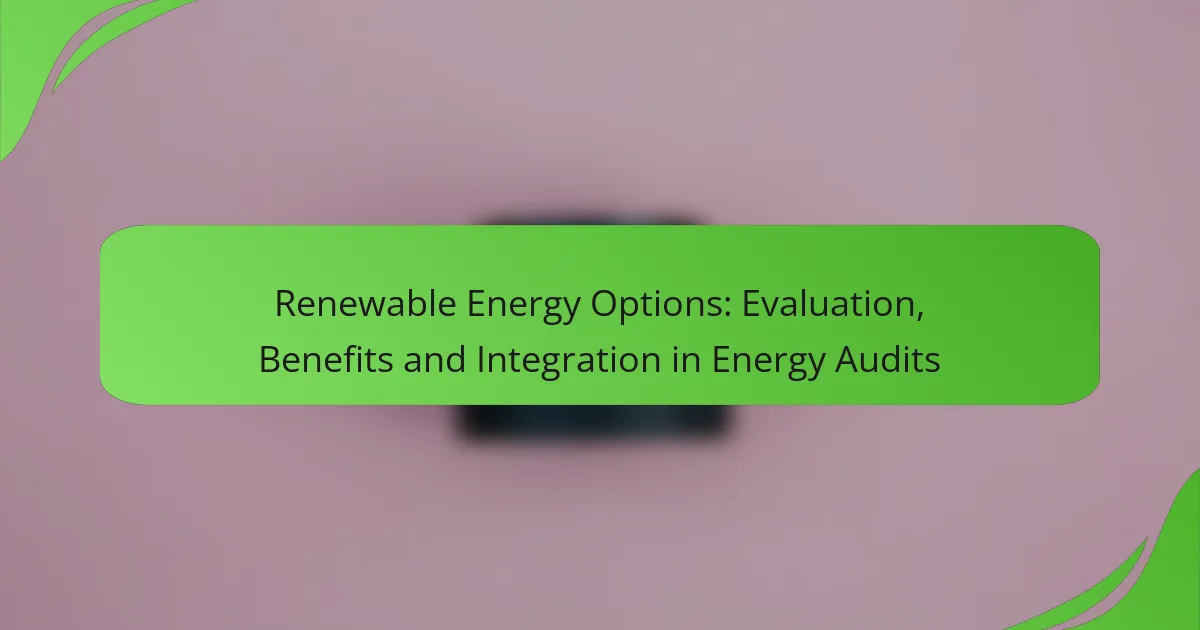Renewable energy options present a viable pathway for businesses in the UK to reduce their carbon footprint and energy expenses. By integrating systems such as solar, wind, biomass, geothermal, and hydropower, companies can enhance their sustainability efforts while benefiting from potential cost savings and increased property value. Evaluating these options involves considering initial investments, return on investment, and local regulations, all of which play a crucial role in the decision-making process.
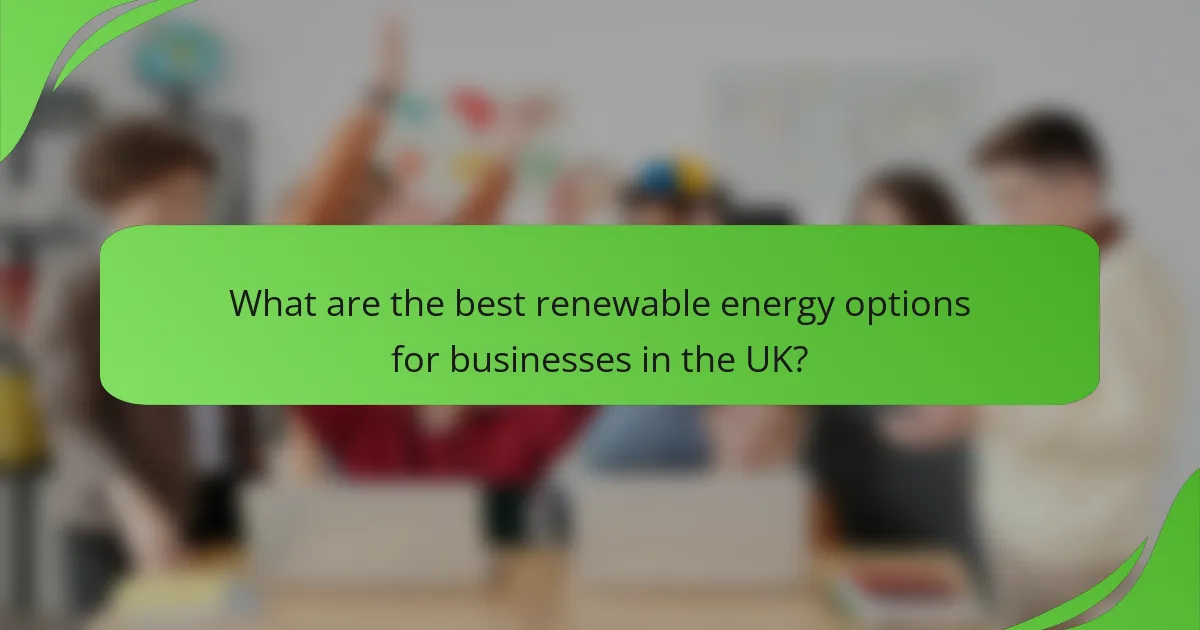
What are the best renewable energy options for businesses in the UK?
The best renewable energy options for businesses in the UK include solar energy systems, wind energy solutions, biomass energy sources, geothermal energy systems, and hydropower installations. Each option offers unique benefits and considerations that can help businesses reduce their carbon footprint and energy costs.
Solar energy systems
Solar energy systems harness sunlight to generate electricity or heat water. Businesses can install photovoltaic (PV) panels on rooftops or use solar farms to produce energy, which can significantly lower electricity bills.
When considering solar systems, evaluate factors such as roof orientation, available space, and potential shading from nearby structures. The UK receives varying sunlight levels, so a well-placed system can yield substantial savings over time.
Wind energy solutions
Wind energy solutions utilize turbines to convert wind energy into electricity. Onshore and offshore wind farms are common in the UK, providing a clean energy source that can be particularly effective in coastal areas.
Businesses should assess wind patterns and local regulations before investing in wind energy. While initial costs can be high, the long-term benefits often include lower energy costs and potential income from selling excess energy back to the grid.
Biomass energy sources
Biomass energy sources involve using organic materials, such as wood pellets or agricultural waste, to generate heat or electricity. This renewable option can help businesses manage waste while producing energy.
When considering biomass, ensure a reliable supply of feedstock and comply with local emissions regulations. Biomass can be a cost-effective solution, especially for businesses with access to agricultural byproducts.
Geothermal energy systems
Geothermal energy systems tap into the Earth’s internal heat for heating and cooling purposes. This option is less common but can be highly efficient for businesses in suitable locations.
To implement geothermal systems, businesses need to conduct site assessments to determine the feasibility and installation costs. While the initial investment can be significant, the long-term energy savings can be substantial.
Hydropower installations
Hydropower installations generate electricity by harnessing the energy of flowing water. This renewable energy source is particularly effective for businesses located near rivers or streams.
Before investing in hydropower, businesses must consider water rights, environmental impacts, and regulatory requirements. Small-scale hydro installations can provide a reliable energy source and potential income from energy sales.
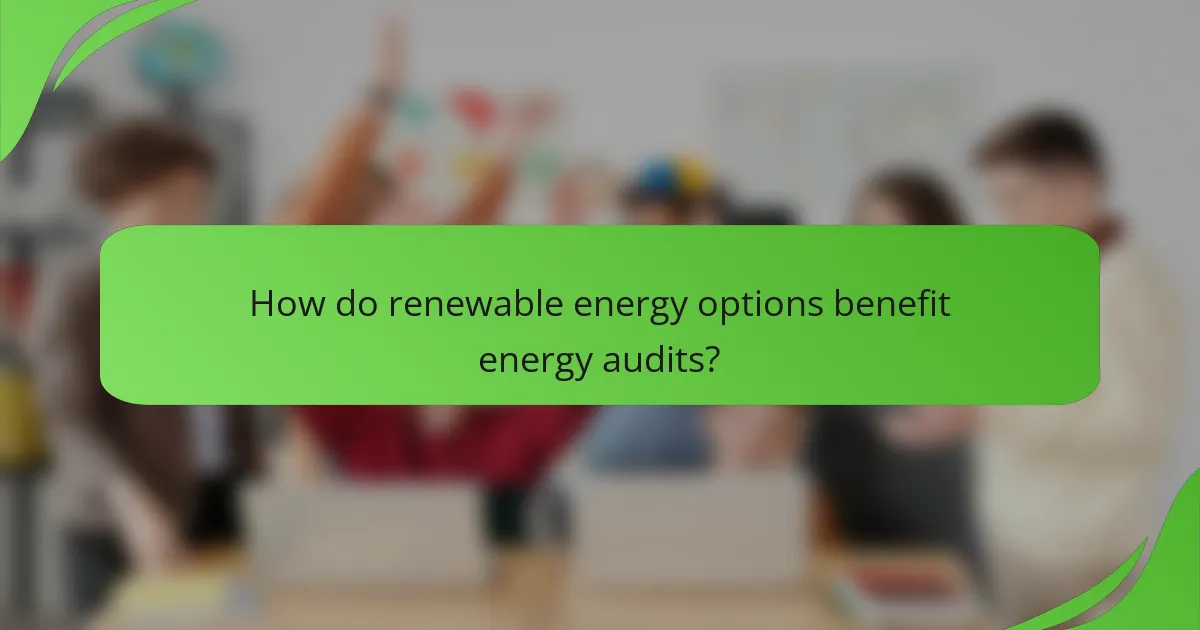
How do renewable energy options benefit energy audits?
Renewable energy options significantly enhance energy audits by identifying potential cost savings, improving sustainability ratings, and increasing property value. These benefits make properties more attractive to investors and occupants while contributing to environmental goals.
Cost savings on energy bills
Implementing renewable energy sources, such as solar panels or wind turbines, can lead to substantial reductions in energy bills. Homeowners and businesses often see savings of 20-50% on their monthly utility costs, depending on the system’s size and local energy prices.
To maximize savings, consider local incentives or rebates that can offset installation costs. Regular maintenance of renewable systems is crucial to ensure they operate efficiently and continue to provide financial benefits over time.
Improved sustainability ratings
Properties utilizing renewable energy sources typically achieve higher sustainability ratings, which are increasingly important in energy audits. Certifications like LEED or BREEAM recognize the environmental benefits of renewable energy, enhancing a building’s reputation.
These ratings can attract environmentally conscious tenants or buyers, making it essential to document energy savings and renewable energy usage during audits. Highlighting these features can significantly improve a property’s marketability.
Enhanced property value
Incorporating renewable energy options can lead to an increase in property value, often by 5-15% or more, depending on the market. Buyers are increasingly looking for energy-efficient homes that promise lower utility costs and a reduced carbon footprint.
When preparing for an energy audit, ensure that all renewable energy installations are documented and highlighted. This documentation can serve as a selling point, showcasing the long-term financial and environmental benefits to potential buyers.

What factors should be considered when evaluating renewable energy options?
When evaluating renewable energy options, key factors include initial investment costs, return on investment timelines, and local regulations and incentives. These elements significantly influence the feasibility and attractiveness of adopting renewable energy solutions.
Initial investment costs
Initial investment costs refer to the upfront expenses required to install renewable energy systems, such as solar panels or wind turbines. These costs can vary widely based on technology, scale, and location, often ranging from a few thousand to several tens of thousands of dollars.
It’s essential to consider not only the purchase price but also installation fees, permits, and any necessary upgrades to existing infrastructure. Conducting a thorough cost analysis helps determine the financial viability of the project.
Return on investment timelines
Return on investment (ROI) timelines indicate how long it will take to recoup the initial investment through energy savings or revenue generation. For many renewable energy systems, ROI can range from 5 to 15 years, depending on factors like energy prices and system efficiency.
Understanding the ROI timeline is crucial for decision-making. Shorter timelines may indicate a more attractive investment, while longer timelines might require a more in-depth analysis of long-term benefits and sustainability.
Local regulations and incentives
Local regulations and incentives can significantly impact the feasibility of renewable energy projects. Many regions offer tax credits, rebates, or grants to encourage the adoption of renewable technologies, which can lower initial costs and improve ROI.
Additionally, it’s important to understand zoning laws, building codes, and interconnection standards that may affect project implementation. Engaging with local authorities early in the evaluation process can help navigate these regulations effectively.
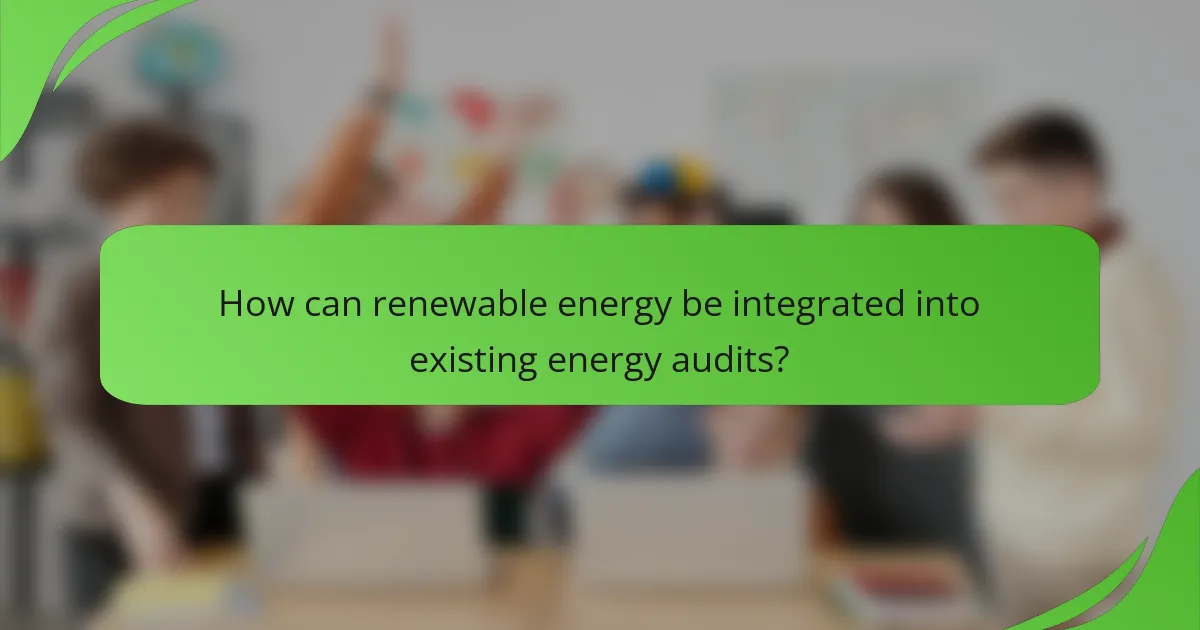
How can renewable energy be integrated into existing energy audits?
Integrating renewable energy into existing energy audits involves evaluating current energy usage, identifying suitable renewable technologies, and planning for implementation. This process enhances energy efficiency and sustainability while potentially reducing costs over time.
Assessment of current energy consumption
The first step in integrating renewable energy is to conduct a thorough assessment of current energy consumption. This includes analyzing utility bills, identifying peak usage times, and understanding energy-intensive processes. Gathering this data helps pinpoint areas where renewable energy can be most effective.
Consider using energy monitoring tools to track real-time consumption. This can reveal patterns and opportunities for energy savings, which are crucial for determining the feasibility of renewable options.
Identification of suitable renewable technologies
After assessing energy consumption, the next step is to identify suitable renewable technologies. Common options include solar panels, wind turbines, and biomass systems, each with varying installation costs and energy outputs. The choice depends on factors like location, available space, and energy needs.
For example, solar energy is often ideal for residential areas with ample sunlight, while wind energy may be more suitable for open spaces with consistent wind patterns. Evaluating local incentives or rebates can also influence technology selection.
Implementation planning and timelines
Implementation planning involves creating a detailed roadmap for integrating renewable energy technologies. This includes setting realistic timelines, budgeting for installation, and considering regulatory requirements. It’s essential to factor in the time needed for permits and inspections, which can vary by location.
A phased approach can be beneficial. Start with smaller projects, such as installing solar panels, and gradually expand to larger systems. Regularly review progress and adjust plans as necessary to ensure successful integration of renewable energy into the overall energy strategy.
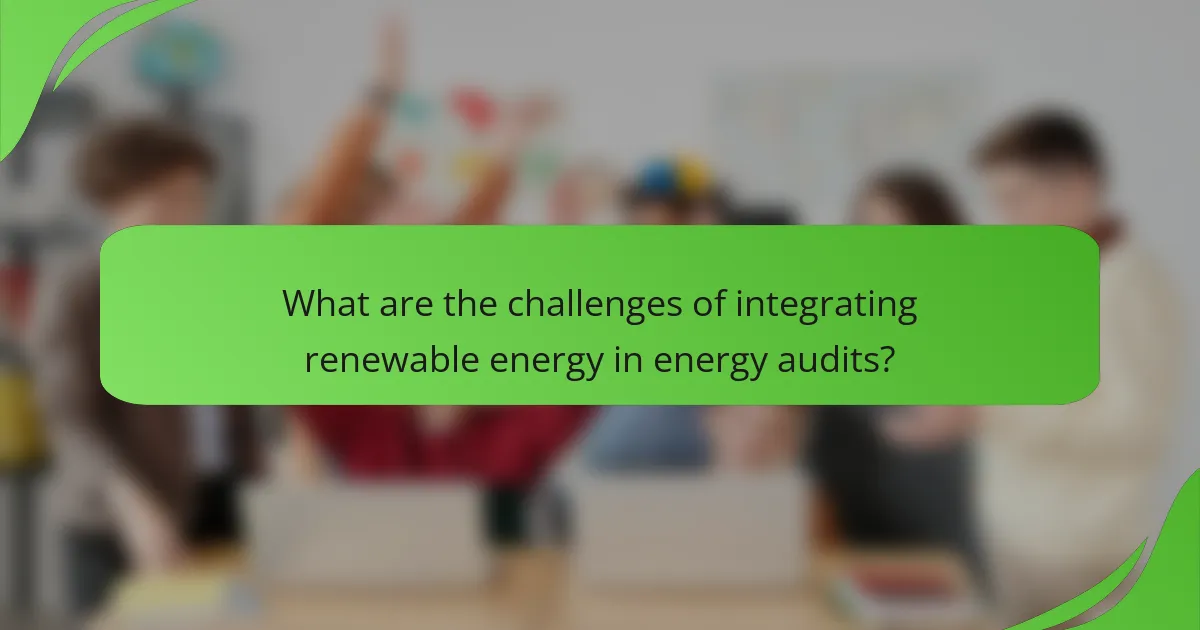
What are the challenges of integrating renewable energy in energy audits?
Integrating renewable energy into energy audits presents several challenges, primarily related to measurement, variability, and regulatory compliance. These factors can complicate the assessment of energy efficiency and the overall effectiveness of renewable systems.
Measurement and Verification Issues
Accurately measuring the performance of renewable energy systems can be difficult due to fluctuating output levels, particularly with solar and wind energy. Energy audits must account for these variations, which can lead to discrepancies in expected versus actual energy savings.
To address measurement challenges, auditors should employ advanced metering technologies and data analytics. Regular monitoring and verification processes can help ensure that renewable systems are performing as intended, providing reliable data for audits.
Regulatory and Compliance Challenges
Compliance with local regulations and standards is essential when integrating renewable energy into energy audits. Different regions may have varying requirements regarding renewable energy credits, emissions reductions, and reporting protocols.
Auditors should familiarize themselves with relevant regulations, such as the Renewable Energy Directive in the EU or state-specific mandates in the U.S. This knowledge will help ensure that audits are compliant and that any incentives or benefits are maximized.
Financial Considerations
Financial challenges can arise when integrating renewable energy into energy audits, including upfront costs, financing options, and return on investment. While renewable systems can lead to long-term savings, initial investments may be a barrier for some organizations.
To mitigate financial concerns, organizations should explore various funding sources, such as government grants, tax incentives, or green financing options. Conducting a cost-benefit analysis can help identify the most viable renewable energy solutions for specific situations.
Technical Integration with Existing Systems
Integrating renewable energy sources with existing energy systems can be technically complex. Compatibility issues may arise, particularly when retrofitting older infrastructure to accommodate new technologies.
To facilitate smoother integration, organizations should conduct thorough assessments of their current systems and consult with experienced professionals in renewable energy. This approach can help identify potential challenges and ensure that new installations complement existing energy frameworks effectively.
